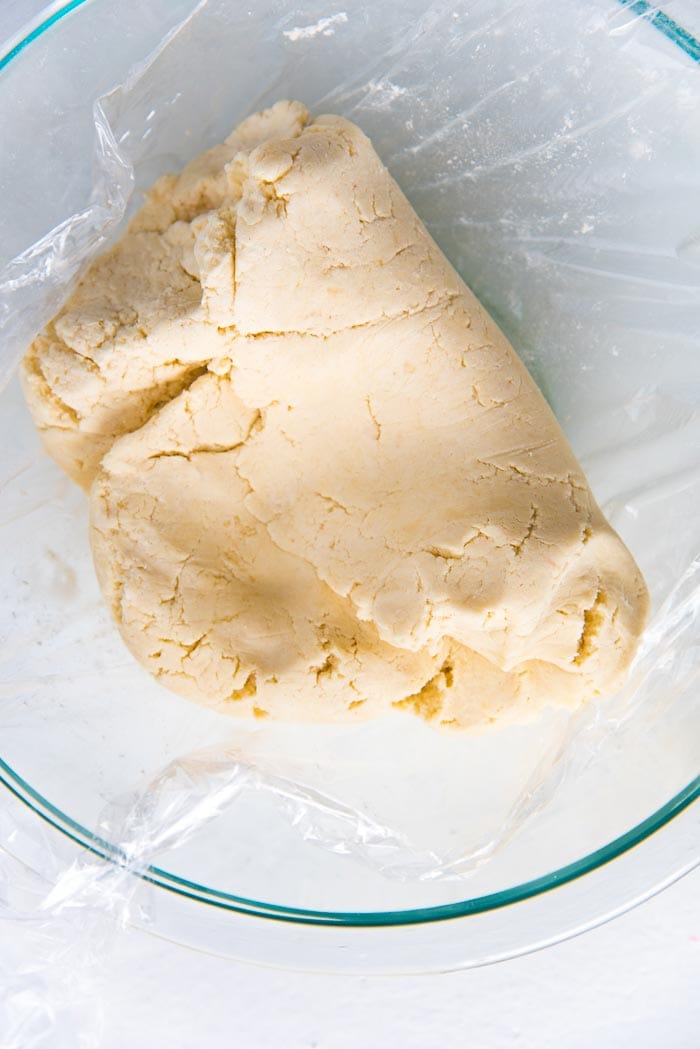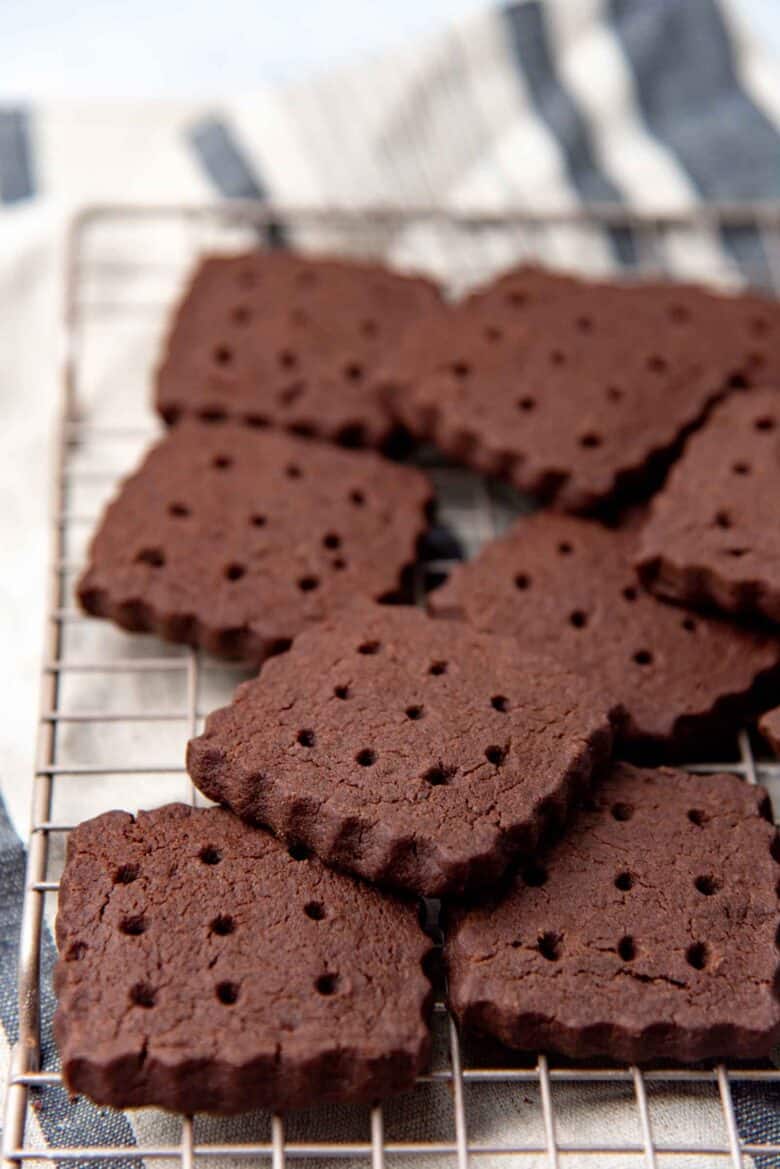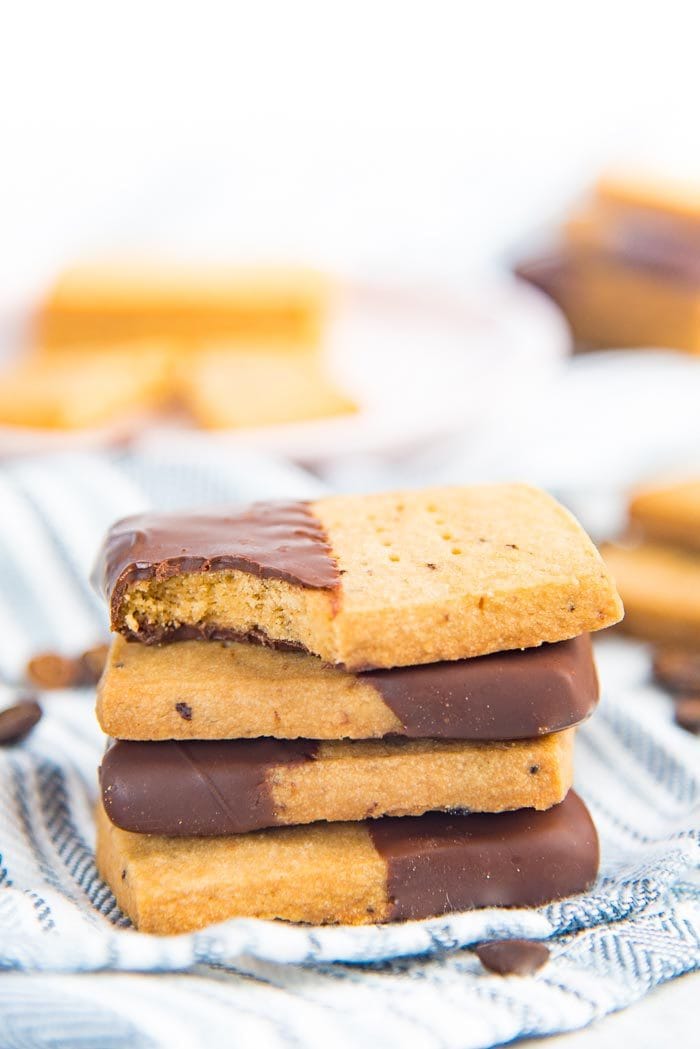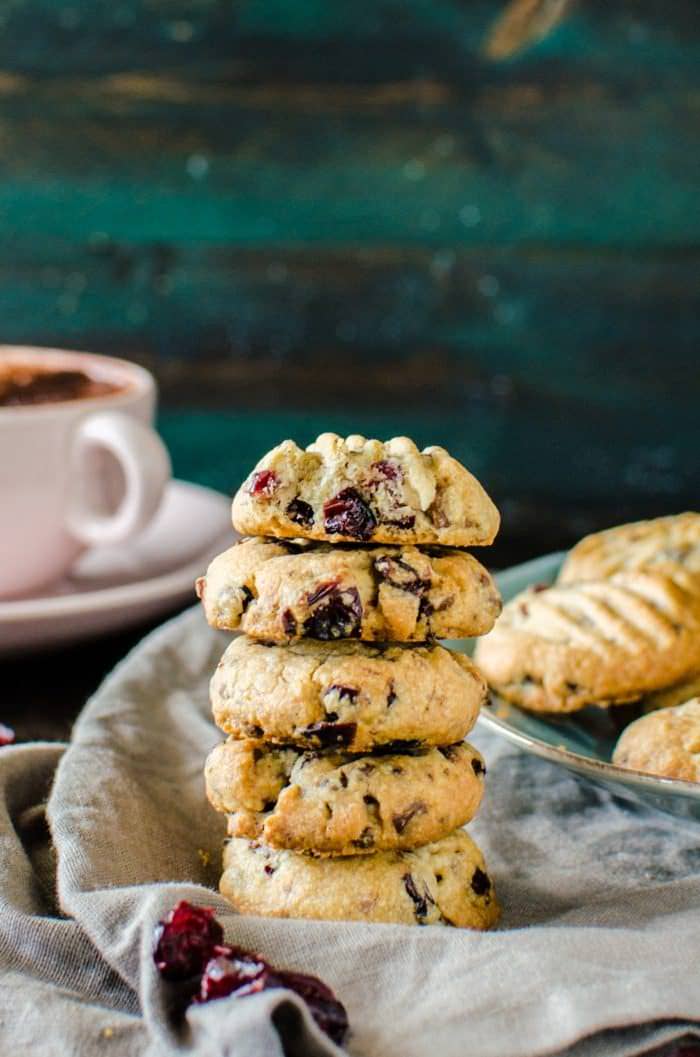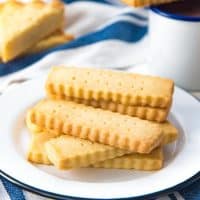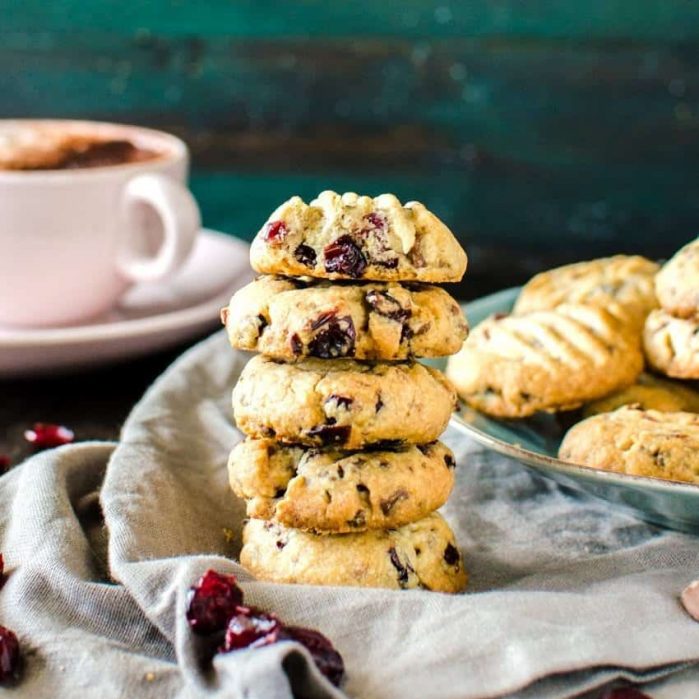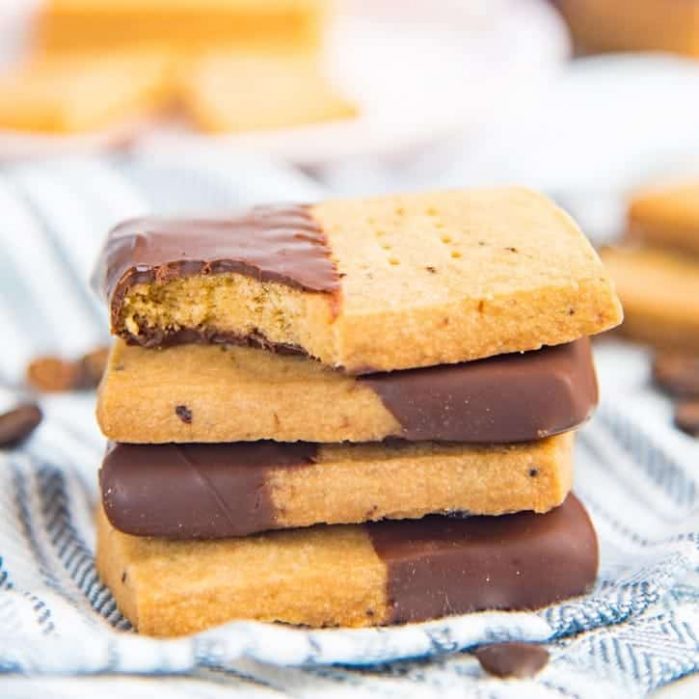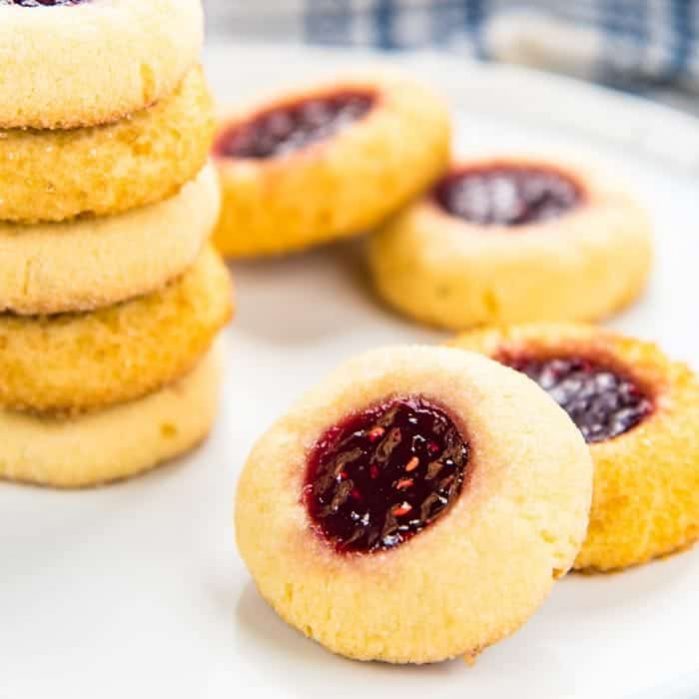I provide ALL the tips to help you make PERFECT shortbread cookies, as well as the softer Scottish shortbread cookies. I make cookie boxes for friends every year during Christmas time. Along with my thumbprint cookies, Mexican wedding cookies (aka snowball cookies), ginger cookies, linzer cookies, and funfetti cookies, these shortbread cookies are always featured in these cookie boxes. And these delicious cookies are always a crowd favorite! I’ve been baking shortbread cookies for as long as I can remember, so I thought I’d share with you guys my basic recipe for classic shortbread cookies. Once you nail this base recipe, switching it up with other flavors and ingredients is so simple. Check out my chocolate shortbread cookies, buttery espresso shortbread cookies, and chocolate chip shortbread cookies, and spiced millionaires shortbread cookie bars for more ideas and inspiration!
What are shortbread cookies?
Just like shortcake or shortcrust pastry, shortbread cookies get their “short” prefix because of the crumbly texture. The large amount of butter in the cookies makes them crumbly, while also giving them a nice buttery flavor. Shortbread cookies are insanely popular throughout the world. They originated in Scotland. Traditional shortbread cookies are typically thick, and cooked at low temperature, resulting in delightfully buttery and crumbly cookies.
Modern shortbread cookies
Shortbread cookies today come in different shapes and forms. You can shape them into wedges (the classic shape), or into fingers (my favorite), circles, or use cookie cutters to get whatever shape you fancy. And instead of regular buttery shortbread cookies, you can make flavored shortbread cookies, or dip them in chocolate and add nuts or sprinkles! So, let’s look at how to make butter shortbread cookies and also how to make Scottish shortbread cookies.
Why you’ll love this recipe
These shortbread cookies are the real deal! Buttery, crumbly, with a lovely buttery but sandy mouthfeel. Just the way shortbread should taste like. You only need 3 ingredients for this shortbread cookies recipe. I provide detailed instructions so that it’s easy even for beginners to make shortbread cookies. Follow my pro tips below, so that rolling shortbread cookies becomes such a breeze! Easily adaptable recipe, so that you can add other flavors to your shortbread cookie dough. Perfect for the holiday season and for gift-giving.
Ingredients to make these cookies
THREE basic ingredients are all you need to make classic shortbread cookies. You can make perfect shortbread cookies with just these three ingredients. But you can also change up the flavor and texture of these ingredients to make these shortbread cookies taste even better. Here’s how.
Butter
The one thing that you shouldn’t skimp on with shortbread cookies is the butter. They are butter shortbread cookies after all. So, use a GOOD QUALITY butter, because the flavor of butter is first and foremost in this buttery shortbread cookie recipe. European butter is even better, because it has a better taste AND has less water than other types of butter. More fat in the butter makes for a better tasting butter, which means you can make a better tasting shortbread cookie. It’s the same principle that applies to rich pastries such as French croissants.
How to enhance the butter flavor for these cookies
Melt the butter and toast it to turn it into brown butter. But, if you do that, remember to return the brown butter to the fridge so that it hardens again, and you will need to re-measure the butter as well. Never make shortbread cookies with melted butter! Salt is also a crucial ingredient when it comes to baking, because it can coax out more flavor from your baked goods. You can make these shortbread cookies with good quality salted butter if you like, but I prefer to add salt separately as I mix the unsalted butter. This lets me control the amount of salt I add to the butter, AND I can use a clean tasting sea salt as well. That way you get the best of both ingredients. Another reason is that salted butter has MORE water content than unsalted butter, and that can have an impact on the taste.
Sugar
Caster sugar (or superfine sugar or baker’s sugar) is the sweetener of choice for me for these cookies. The fine sugar granules dissolve in the butter a lot faster, and this is crucial for shortbread cookies. Undissolved sugar crystals in the dough can cause the cookies to spread too much as they dissolve in the oven, and change the texture of the cookies. Even if you can’t find superfine sugar, no worries – you can simply use regular granulated sugar and then process it in a blender or food processor for a few seconds or up to a minute to make it finer. You CAN also use confectioner’s sugar (icing sugar) for this recipe. But remember confectioner’s sugar is a mixture of sugar and cornstarch. So, instead of using 4 oz of sugar, you’d have to use 5 oz of confectioner’s sugar to achieve the same level of sweetness. This might make your shortbread cookies a little crumblier than usual, since the amount of flour will be the same. But it won’t take away from the flavor though! You can read my baking basics article on guide to types of sugar for more information on choosing the right type of sugar for all your baking needs.
Flour
You can make the most amazing buttery shortbread cookies with just all purpose flour, mixed in with butter and sugar. This is how classic shortbread recipes were always made. However, I like to replace SOME of the flour with rice flour or cornstarch. The reason is that rice flour or cornstarch changes the texture, and turns these into melt in your mouth cookie with a lighter, nicer mouthfeel. If I have rice flour at home, then that’s my first choice. If not, then I’ll use cornstarch. And if I have neither, then I’ll just stick with all AP flour. This is just a simple way for you change up your shortbread cookie game, and alter their flavor and texture. It’s this short list of ingredients that makes easy shortbread cookies different from sugar cookies too. Sugar cookies (like these funfetti cookies) also include flavoring, eggs, and a leavening agent like baking soda or baking powder. Homemade shortbread cookies do NOT contain eggs or a leavening agent, although flavoring can certainly be added. And as the name implies, sugar cookies have a higher sugar content and are sweeter, and also lighter and more crisp as well.
How to make the best shortbread cookies (with tips)
Step one – cream the butter
The first step is creaming the butter. But make sure NOT to incorporate too much air into the butter when you do this. The more air you introduce, the more spreading that will occur as the cookies bake. So beat the butter just enough to make it nice and creamy, but not fluffy. I like to add the salt at the same time as I cream the butter, but you can add it along with the sugar in the next step as well.
Step two – add the sugar
The second step is adding the sugar. And since you want to avoid incorporating too much air, it’s important that the sugar dissolves easily into the butter as well. This is where superfine sugar really helps. It mixes and dissolves quickly, leaving no unsightly, undissolved granules in the dough. So, mix the butter and sugar just enough until you get a smooth paste, but again, make sure it’s not too fluffy.
Step three – add the flour
Third step is adding the flour. I like to add AP flour and other flours together. If you’re using only AP flour, that’s OK too. Just make sure there are no lumps in the flour, and that you add them at the same time. You want to mix the flour into the dough with minimal effort, in the minimum amount of time. The longer you work the dough with the flour, the more gluten you develop, causing the cookies to be chewy and tough, instead of light and crumbly. I only use the LOWEST speed on my mixer (stand mixer or hand mixer) to incorporate flour into the butter-sugar mix. Mix it just enough to create clumps of flour, with no dry spots, and then immediately stop mixing.
Step four – make the dough
Fourth step is to bring the clumps of flour together to make a cohesive ball of dough. Fold and knead the dough two or three times (very gently), to bring the dough together if needed. Now, the dough is ready to be rolled out and cut out for the best shortbread cookies!
My BEST tips for shortbread cookies
Make shortbread with good quality ingredients! Since this simple recipe has so few ingredients, make sure you’re using good quality ones. Especially with the butter! A butter that tastes good will result in the best buttery shortbread cookies. Just as with any cake or cookie recipe, do not overmix the flour. The more the flour is mixed, the more gluten is developed. This will result in a hard, rubbery cookie. Bring the dough together by hand. Once all the flour is added, use your hands to form the dough. This also prevents the dough from being overmixed. I share my favorite tip for making shortbread dough – using a ziploc bag to roll out dough (see below)! This addresses so many problems that can arise from making shortbread cookies. Ziploc bags also make it super easy to make the dough in advance and refrigerate or freeze for later! You can cut the dough into individual cookies like classic shortbread cookies, or use cookie cutters to cut them in different ways as well. Shortbread cookies with an even thickness will bake evenly. Use dough thickness guides to ensure that your dough is rolled out with an even thickness.
Is there an easy way to roll and cut shortbread cookies?
YES! This brings me to my secret weapon – my favorite trick for making shortbread cookies! Put the dough in a gallon-size ziploc bag. Trust me, this is a game-changer if you want to make individual shortbread cookies (cut out shortbread cookies, instead of Scottish shortbread cookies). I learned this trick ages ago, when I was first struggling to roll out the shortbread cookie dough to an even thickness, with minimal dough scraps. I’d roll out the cookie dough with wax paper or parchment paper or plastic wrap to prevent the dough from sticking to the surface. But I always ended up with dough scraps when I cut out the cookies, because it was too hard to roll it out to a proper square or rectangle AND an even thickness. Plus I end up over-handling the dough, which is never a good thing. The gallon ziploc bag fixes this issue! No more sticky dough. Instead, perfect smooth surfaces, and minimal dough scraps. PLUS, you will have rolled out your shortbread cookie dough to the size you want in a matter of minutes. Put the dough inside the gallon ziploc bag, and press the dough into the corners of the bag. And then using a rolling pin, evenly press it to make an evenly thick slab of dough inside the bag. Keep the bag open to allow excess air to escape. Roll out the dough, while it’s inside the bag, until it’s about 1/2 inch thick, evenly, and rectangular in shape (it won’t fill the whole gallon bag). This way you end up with a perfectly rolled shortbread dough, with minimal fuss. Then chill the dough, so that it’s easier to cut into fingers (or any other shape you like using cookie cutters), pierce the cookies with a fork (to minimize spreading), and chill the cut cookie dough a little more before baking.
Tips to minimize cookie spreading
Do not incorporate too much air into the dough. The more you beat the butter and sugar, the more air you add to the dough. This results in the cookies expanding and spreading as they bake. Always use a baking sheet that is at room temperature or chilled. Warmer baking trays will melt the butter and encourage the cookies to spread while baking. Do not bake the cookies at a low temperature. Cut shortbread cookies should be baked at 350 F / 180 C. The higher heat will set the cookies faster, and prevent too much spreading. However, Scottish shortbread cookies are baked at a lower temperature because they are much larger and are contained in the baking dish. Therefore, it must be baked slowly for even baking.
What are Scottish shortbread cookies?
Scottish shortbread cookies are made using the same shortbread dough, but are shaped and baked slightly differently. Instead of cut individual cookies, Scottish shortbread cookie dough is baked as one large dough. And it’s baked WITHIN the baking pan, and THEN cut into individual cookies. These can be wedge shaped (baked as a circle), or rectangle (baked as a square or rectangle). The resulting cookies are a little softer, and more crumbly than classic shortbread cookies. They can also be a little thicker.
How to make Scottish shortbread cookies
These are more crumbly, softer, and thicker shortbread cookies. This very same shortbread dough can be used to make Scottish shortbread cookies. Here’s how. Once you’ve made the shortbread dough, transfer it into a ziploc bag, or place it between two parchment paper sheets. At this point, you need to decide whether you want to make Scottish shortbread cookies as a wedge (classic shape), or rectangles, so that you know which pan to use for baking. For wedges – Springform circle pan (8 or 9 inch) For rectangles – Square pan (8 inch) Gently press the dough and shape it a little smaller than the size of the pan you’re going to use (square or circle). Then transfer the dough into the lined pan, and press it towards the edges of the pan, while making sure the dough has an even thickness everywhere. I use a toothpick to make sure that it’s even along the edges of the pan. An 8 inch round pan will create shortbread cookies that are about 1 inch thick, and a 9 inch round pan or 8 inch square pan will create shortbread cookies that are about 1/2 – 3/4 inch thick. Cut the dough into wedges while in the pan. Bake the cookie dough at a lower temperature, until the dough is mostly cooked through. Then cut the cookies along the same cuts you made earlier, and bake the individual cookies in the oven for just a few more minutes, until you get thick and delightfully buttery Scottish shortbread cookies!
Recipe variations and substitutions
Flavor additions
Usually, butter shortbread cookies do not need any flavoring. However, you can absolutely add flavoring if you prefer. Here are some options.
Vanilla extract Almond extract Orange or lemon extract Orange or lemon zest Espresso powder for espresso shortbread cookies Cocoa powder for chocolate shortbread cookies Other additions that can be added to shortbread cookie dough Mini chocolate chips for chocolate chip shortbread cookies Finely chopped roasted nuts – hazelnut, almond, walnut or praline shortbread cookies. Funfetti sprinkles – for funfetti shortbread cookies Finely chopped dried fruits like raisins, craisins, dried apricots, or dried cherries, or dried cranberry for cranberry shortbread cookies Make shortbread cookie balls and fill them with jam or jelly for a unique cookie ball version of thumbprint cookies
Ideas for glazes or toppings
I personally don’t think shortbread cookies need anything on top, but there are great ways to make these cookies even more decadent.
Millionaires shortbread bars – These bars can be topped with caramel and chocolate to make millionaires bars or twix bars. Chocolate dipped shortbread cookies – Dip individual cookies in melted chocolate, like I did with these espresso shortbread cookies. Royal icing – These cookies can be used like cut out cookies and be decorated with royal icing and sprinkles. Buttercream frosting – Just like buttercream topped sugar cookies, but with shortbread cookies. Sandwich cookies – Shortbread cookie dough can be used to make sandwich cookies like these melting moments cookies with a ganache filling in the middle.
Frequently asked questions
If you liked this easy shortbread cookies recipe, don’t forget to subscribe for new (and free) recipes by entering your email address on the side bar (and get all these recipes delivered straight to your inbox), so you don’t miss out on a thing. You can find me on FACEBOOK, TWITTER, INSTAGRAM, PINTEREST, YOU TUBE and GOOGLE-PLUS too.







